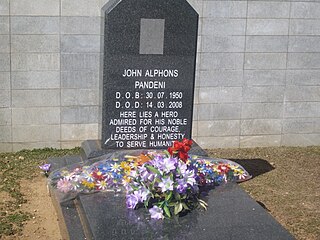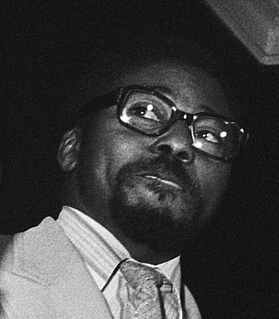
The South West Africa People’s Organisation, officially known as the SWAPO Party of Namibia, is a political party and former independence movement in Namibia. It has been the governing party in Namibia since the country achieved independence in 1990. The party continues to be dominated in number and influence by the Ovambo ethnic group.

Samuel Shafiishuna Daniel Nujoma, is a Namibian revolutionary, anti-apartheid activist and politician who served three terms as the first President of Namibia, from 1990 to 2005. Nujoma was a founding member and the first president of the South West Africa People's Organization (SWAPO) in 1960. Prior to 1960, SWAPO was known as the Ovambo People's Organisation (OPO). He played an important role as leader of the national liberation movement in campaigning for Namibia's political independence from South African rule. He established the People's Liberation Army of Namibia (PLAN) in 1962 and launched a guerrilla war against the apartheid government of South Africa in August 1966 at Omungulugwombashe, beginning after the United Nations withdrew the mandate for South Africa to govern the territory. Nujoma led SWAPO during the lengthy Namibian War of Independence, which lasted from 1966 to 1989.
Hidipo Livius Hamutenya was a Namibian politician. A long time leading member of the South West Africa People's Organization (SWAPO), Hamutenya was a member of the Cabinet of Namibia from independence in 1990 to 2004. He was defeated in a bid for the party's presidential nomination in 2004 and left SWAPO to form an opposition group, the Rally for Democracy and Progress (RDP), in 2007. He was elected to the National Assembly of Namibia with RDP in the 2009 general election. He was forced to step down as RDP President on 28 February 2015 and rejoined SWAPO on 28 August 2015.

Hifikepunye Lucas Pohamba is a Namibian politician who served as the second President of Namibia from 21 March 2005 to 21 March 2015. He won the 2004 election overwhelmingly as the candidate of SWAPO, the ruling party, and was reelected in 2009. Pohamba was the president of SWAPO from 2007 until his retirement in 2015. He is a recipient of the Ibrahim Prize.
Mansudae Overseas Projects is a construction company based in Jongphyong-dong, Phyongchon District, Pyongyang, North Korea. It is the international commercial division of the Mansudae Art Studio. As of August 2011, it had earned an estimated US$160 million overseas building monuments and memorials. As of 2015, Mansudae projects have been built in 17 countries: Angola, Algeria, Benin, Botswana, Cambodia, Chad, Democratic Republic of Congo, Egypt, Equatorial Guinea, Ethiopia, Germany, Malaysia, Mali, Mozambique, Namibia, Senegal, Togo and Zimbabwe. The company uses North Korean artists, engineers, and construction workers rather than those of the local artists and workers. Sculptures, monuments, and buildings are in the style of North Korean socialist realism.

Hage Gottfried Geingob is a Namibian politician, serving as the third President of Namibia since 21 March 2015. Geingob was the first Prime Minister of Namibia from 1990 to 2002, and served as prime minister again from 2012 to 2015. Between 2008 and 2012 Geingob served as Minister of Trade and Industry. He is also the current president of the ruling SWAPO Party since his election to the position in November 2017.
Benjamin Ulenga is a Namibian politician. In the 1990s, he served under the SWAPO government as a deputy minister and as an ambassador, but he left SWAPO in 1998 and founded an opposition party, the Congress of Democrats (CoD), in 1999. He was a member of the National Assembly of Namibia from 2000 to 2015 and led the CoD until 2015.
Ngarikutuke Ernest Tjiriange was a Namibian politician, a member of the National Assembly and former secretary-general of the ruling SWAPO Party. He also served in the Namibian cabinet from 1990 to 2010, first as Minister of Justice, then without portfolio, and then as Minister of Veterans' Affairs.
Pendukeni Iivula-Ithana is a Namibian politician who served as the Secretary-General of the South-West Africa People's Organization (SWAPO) from 2007 to 2012. She was also Minister of Justice from 2005 to 2012 and Minister of Home Affairs from 2012 until February 2018 when president Hage Geingob relieved her off her duties in a cabinet reshuffle.

John Alphons Pandeni was a Namibian politician and trade unionist. A member of SWAPO, Pandeni was Minister of Regional and Local Government, Housing and Rural Development at the time of his death in 2008.
Richard Nchabi Kamwi is a Namibian medical physician and politician. A member of the National Assembly with the South West Africa People's Organization since 1999, Kamwi was the Minister of Health and Social Services from March 2005 to 2015.
2009 in Namibia refers to the events which occurred and will occur in the year of 2009 in the Republic of Namibia.

The Cabinet of Namibia is an appointed body that was established by the Chapter 6 of the Constitution of Namibia. It is mandated to include the following positions: the President of Namibia, the Prime Minister of Namibia and any positions that the President so appoints.

Penehupifo "Penny" Pohamba is a Namibian educator and politician who was the second First Lady of Namibia while her husband, Hifikepunye Pohamba, was President of Namibia from 2005 to 2015.
The following lists events that happened during 2005 in Namibia.

Carl-Hermann Gustav "Calle" Schlettwein is a Namibian politician who has served in the country's cabinet since 2012. In March 2020, he was appointed the Minister of Agriculture, Water and Land Reform after serving as the Minister of Finance from 2015 to 2020 and previously as the Minister of Trade and Industry from 2012 to 2015.

Namibia–North Korea relations refers to the current and historical relationship between Namibia and the Democratic People's Republic of Korea (DPRK). Neither country maintains an embassy in their respective capitals, although DPRK formerly had one in Windhoek, which closed down in 1994.

Peter Hitjitevi Katjavivi is a Namibian politician who is the Speaker of the National Assembly of Namibia since March 2015 and the chancellor of the Namibia University of Science and Technology from 1992 to 2003. Previously he was the founding Vice-Chancellor of the University of Namibia from 1992 to 2003, Ambassador to the European Union from 2003 to 2006, Ambassador to Germany from 2006 to 2008, and Director General of the National Planning Commission from 2008 to 2010.

The Independence Memorial Museum is a historical museum in Windhoek, Namibia. It focuses on the anti-colonial resistance and the national liberation struggle of Namibia. The museum is located on Robert Mugabe Avenue and was designed and built by Mansudae Overseas Projects, a North Korean firm. The museum was inaugurated on March 21, 2014, the twenty-fourth anniversary of independence of the country, by President Hifikepunye Pohamba. The museum is flanked by two statues: the Sam Nujoma Statue and the Genocide Statue, also built by Mansudae. The Sam Nujoma Statue sits on the site of the German-era Reiterdenkmal equestrian statue.

Brazil–Namibia relations refers to the diplomatic relations between the Federative Republic of Brazil and the Republic of Namibia. Both nations are members of the Group of 77 and the United Nations.














